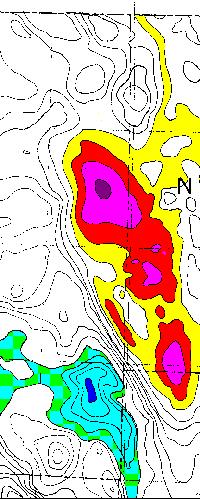
by
Richard I. Gibson
Gibson Consulting
The full paper with 10 figures is available in the Seventh International Williston Basin Symposium Guidebook (1995), L. Hunter and R. Schalla, eds. (Montana Geol. Soc., North Dakota Geol. Soc., Saskatchewan Geol. Soc., and Fort Peck Tribes)
 The Williston Basin is a virtual casebook of basement tectonic features repeatedly affecting sedimentation and hydrocarbon accumulation. Archean (>2.5 billion years old) and Early Proterozoic Trans-Hudson structures (1.85-1.95 billion years old) were subtly reactivated during the Paleozoic to guide aspects of deposition, and at least by Laramide time (Late Cretaceous to Eocene) they were significantly rejuvenated as faults and folds that control the distribution of important modern hydrocarbon pools such as the Cedar Creek and Nesson Anticlines. The Williston Basin is a virtual casebook of basement tectonic features repeatedly affecting sedimentation and hydrocarbon accumulation. Archean (>2.5 billion years old) and Early Proterozoic Trans-Hudson structures (1.85-1.95 billion years old) were subtly reactivated during the Paleozoic to guide aspects of deposition, and at least by Laramide time (Late Cretaceous to Eocene) they were significantly rejuvenated as faults and folds that control the distribution of important modern hydrocarbon pools such as the Cedar Creek and Nesson Anticlines.
Basement features in this area are clearly expressed in gravity and magnetic data. Their primary expression is as alternating relatively intense highs and lows that are fundamentally intrabasement lithologic contrasts. Because of the demonstrable reactivation of these lithologic contacts as structures, we can make some predictions about possible structural development in other, less obvious areas.
The Cedar Creek Anticline (gravity map at right) is a prime example that shows repeated rejuvenation of an Archean lithologic contact — possibly the contact that marks the edge of the Wyoming Craton. The Cedar Creek feature was a fault by late Silurian time (Clement, 1986), and it had a significant impact on paleotopography and facies during Mississippian time. The Laramide down-to-the-southwest fault along this line juxtaposes relatively magnetic material on the downthrown side of the fault; the magnetic high there correlates with a gravity low. Analogs to the Cedar Creek basement feature can be identified in several locations in the Basin.
Ordovician Red River facies trends may be affected by basement features similar to those at Cedar Creek.
The Nesson Anticline also follows old basement lithologic boundaries. Its north-south trend indicates that the contacts are part of the Trans-Hudson Orogen. The magnetic anomaly at Nesson Field comes from an intrabasement source, about 8,000 feet deeper than the Precambrian basement surface. This indicates that the Nesson structure extends well into the basement. Details of the geometry of the Nesson Field complex are visible in magnetic data. Possible analogs to Nesson are all smaller and deeper in terms of basement tectonics.
Subtle northeast-trending disruptions in the gravity and magnetic data correlate with lines of small fields and may be related to facies such as oolite shoals in the Mississippian carbonates. Basement tectonics, inferred from gravity and magnetics, can be used as a guide to exploration in many if not all parts of the multiple plays present in the Williston Basin.
Back to Abstracts Index
Back to US Products Index
|